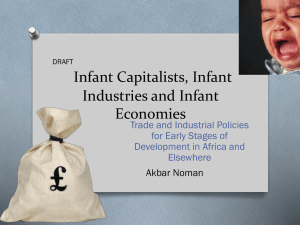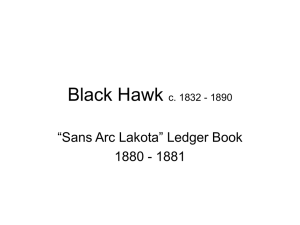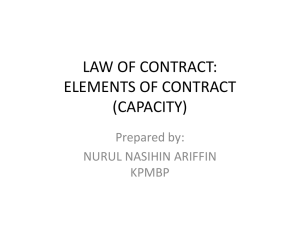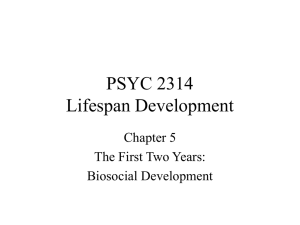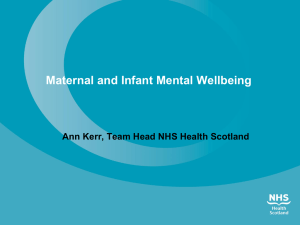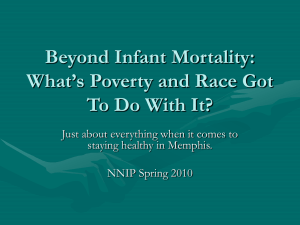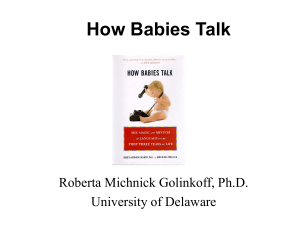Chapter Six - Black Hawk College
advertisement
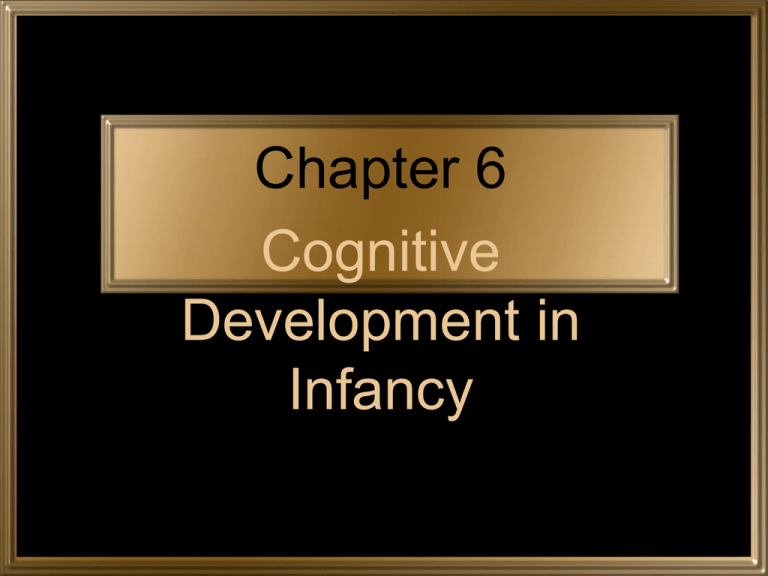
Chapter 6 Cognitive Development in Infancy Cognitive Development in Infancy Piaget's Theory of Infant Development Learning and Remembering Individual Differences in Intelligence Black Hawk College Chapter 6 Language Development 2 Piaget's Theory of Infant Development The Stage of Sensorimotor Development Substages Object Permanence Black Hawk College Chapter 6 Evaluating Piaget's Theory 3 Piaget’s Theory of Infant Development • Piaget believed that the child passes through a series of stages of thought from infancy to adolescence. • Passage through the stages results from biological pressure to adapt to the environment (through assimilation and accommodation) and to organize structures of thinking. • The stages are qualitatively different from one another; the way that children reason at one stage is different from the way they reason at another stage. • Children have schemes (cognitive structures that help individuals’ organize and understand their experiences) from birth. • Schemes change with age. • As children grow older and gain more experience, they shift from using physically-based schemes to mentally-based schemes. Black Hawk College Chapter 6 4 The Stage of Sensorimotor Development • According to Piaget, this stage lasts from birth to about 2 years of age. • Mental development is characterized by considerable progression in the infant’s ability to organize and coordinate sensations with physical movements and actions. • Children progress from having little more than reflexive patterns to work with to complex sensorimotor patterns and a primitive system of symbols. Black Hawk College Chapter 6 5 Substages • • • • • Simple reflexes First habits and primary circular reactions Secondary circular reactions Coordination of secondary circular reactions Tertiary circular reactions, novelty, and curiosity • Internalization of schemes Black Hawk College Chapter 6 6 Simple Reflexes • Stage corresponds to the first month after birth. • The basic means of coordinating sensation and action is through reflexive behaviors. • The infant develops an ability to produce behaviors that resemble reflexes in the absence of obvious reflexive stimuli (e.g., sucking upon simply seeing a bottle). • This is evidence that the infant is initiating action and is actively structuring experiences in the first month of life. Black Hawk College Chapter 6 7 First Habits and Primary Circular Reactions • This stage develops between 1-4 months of age. • Infants’ reflexes evolve into adaptive schemes that are more refined and coordinated. • A habit is a scheme based on a simple reflex that has become completely separated from its eliciting stimulus. • A primary circular reaction is a scheme based on the infant’s attempt to reproduce an interesting or pleasurable event that initially occurred by chance. Black Hawk College Chapter 6 8 Secondary Circular Reactions • This stage develops between 4-8 months of age. • The infant becomes more object-oriented or focused on the world, moving beyond preoccupation with the self in sensorimotor interactions. • The infant imitates some simple actions and physical gestures of others, but only those he can already produce. Black Hawk College Chapter 6 9 Coordination of Secondary Circular Reactions • This stage develops between 8-12 months of age. • Several significant changes take place that involve the coordination of schemes and intentionality. • Infants readily combine and recombine previously learned schemes in a coordinated way. • Actions are even more outwardly directed. • Related to their coordination is the presence of intentionality: the separation of means and goals in accomplishing simple feats. Black Hawk College Chapter 6 10 Tertiary Circular Reactions, Novelty, and Curiosity • This stage develops between 12-18 months of age. • Infants become intrigued by the variety of properties that objects possess and by the many things they can make happen to objects. • Tertiary circular reactions are schemes in which the infant purposely explores new possibilities with objects, continually changing what is done to them and exploring the results. • Piaget believed this marks the developmental starting point for curiosity and interest in novelty. Black Hawk College Chapter 6 11 Internalization of Schemes • This stage develops between 18-24 months. • The infant’s mental functioning shifts from a purely sensorimotor plane to a symbolic plane. • The infant develops the ability to use primitive symbols (internalized sensory images or words that represent events). • Primitive symbols permit infant to think about concrete events without directly acting out or perceiving them. • Symbols also allow the infant to manipulate and transform the represented events in simple ways. Black Hawk College Chapter 6 12 Object Permanence • Object permanence is the Piagetian term for understanding that objects and events continue to exist, even when they cannot directly be seen, heard, or touched. Black Hawk College Chapter 6 13 Evaluating Piaget’s Sensorimotor Stage • Piaget opened up a whole new way of looking at infants by describing how their main task is to coordinate their sensory impression with their motor activity. • The infant’s cognitive world is not nearly as neatly packaged as Piaget portrayed it, and some of his explanations for the cause of change are debated. • Many of today’s researchers believe that Piaget wasn’t specific enough about how infants learn about their world and that infants are far more competent than Piaget envisioned. Black Hawk College Chapter 6 14 New Perspectives on Infant Development • Perceptual Development • Conceptual Development Black Hawk College Chapter 6 15 Perceptual Development • A number of theorists believe that infants’ perceptual abilities are highly developed very early in development. • Studies have shown that infants as young as 4 months old have intermodal perception—the ability to coordinate information from two or more sensory modalities. • Other research has indicated that 4-month-olds expect objects to be substantial and permanent. • Researchers now believe that infants see objects as bounded, unitary, solid, and separate, possibly at birth or shortly thereafter. • Young infants have much to learn, but the world appears both stable and orderly to them, thus capable of being conceptualized. Black Hawk College Chapter 6 16 Conceptual Development • Piaget constructed his view of infancy mainly by observing his own children as few laboratory techniques were available at the time. • Researchers have since then devised ways to assess whether or not infants are thinking. • These methods have led to findings that indicate that infants have more sophisticated perceptual abilities and can begin to think earlier than Piaget envisioned. • Researchers believe humans are either born with or acquire these abilities early in their development. Black Hawk College Chapter 6 17 Learning and Remembering Conditioning Habituation and Dishabituation Imitation Black Hawk College Chapter 6 Memory 18 Conditioning • Both classical and operant conditioning have been demonstrated to occur in infants. • If an infant’s behavior is followed by a rewarding stimulus, the behavior is likely to recur. • Operant conditioning has been helpful to researchers in their efforts to determine what infants perceive. • Studies have demonstrated that infants can retain information from the experience of being conditioned. Black Hawk College Chapter 6 19 Habituation and Dishabituation • Habituation is the process by which infants become uninterested in a stimulus and respond less to it after it is repeatedly presented to them. • Dishabituation is an infant’s renewed interest in a stimulus. • Newborns habituate in virtually every stimulus modality, but habituation grows more acute over first 3 months. • Habituation can be used to tell us much about infants’ perception, such as the extent to which they can see, hear, smell, taste, and experience touch. • Habituation can tell us whether infants recognize something they have previously experienced. • A knowledge of habituation and dishabituation can benefit parent-infant interactions. Black Hawk College Chapter 6 20 Imitation • Andrew Meltzoff believes infants’ imitative abilities to be biologically based because they can imitate a facial expression within the first few days after birth. • This occurs before they’ve had the opportunity to observe social agents in their environment or the behaviors they have been observed to imitate. • Meltzoff also believes infant imitation involves flexibility, adaptability, and intermodal perception. • Not all experts accept Meltzoff’s conclusions and believe the babies were automatically responding to a stimulus. Black Hawk College Chapter 6 21 Deferred Imitation • Deferred imitation is imitation which occurs after a time delay of hours or days. • Meltzoff found that 9-month-old infants could imitate actions that they had seen performed 24 hours earlier. • Piaget believed that deferred imitation doesn’t occur until about 18 months of age. Black Hawk College Chapter 6 22 Memory • Implicit memory involves retention of a perceptual-motor variety that is involved in conditioning tasks. • Explicit memory is the ability to consciously recall the past. Black Hawk College Chapter 6 23 Memory in Infancy • Memory is a central feature of cognitive development that involves the retention of information over time. • Some argue that infants as young as 2-6 months can remember some experiences through 1½-2 years of age. • Critics of these findings argue that they fail to distinguish between implicit memory and explicit memory. • Most researchers don’t find that explicit memory occurs until the second half of the first year. • Most adults cannot remember anything from the first 3 years of life, a phenomenon referred to as infant amnesia. • One explanation of infant amnesia focuses on the maturation of the brain, especially in the frontal lobes, which occur after infancy. Black Hawk College Chapter 6 24 Individual Differences in Intelligence Black Hawk College Chapter 6 25 Individual Differences in Intelligence • Individual differences in infant cognitive development have been studied primarily through the use of developmental scales or infant intelligence tests. • It is advantageous to know whether an infant is advancing at a slow, normal, or advanced pace of development. • Infant developmental scales differ from those used to assess older children in that they are necessarily less verbal, contain more perceptual motor items, and include measures of social interaction. Black Hawk College Chapter 6 26 Arnold Gesell • Gesell is the most important early contributor to the developmental testing of infants. • He developed a measure used as a clinical tool to help sort out potentially normal babies from abnormal ones. • The Gesell test was widely used years ago, and is still used by pediatricians to assess normal and abnormal infants. • The current version of the Gesell test has 4 categories of behavior: motor, language, adaptive, personal-social. • Results yield an infant’s developmental quotient (DQ)— an overall developmental score that combines subscores in the four categories. Black Hawk College Chapter 6 27 The Bayley Scales of Infant Development • These scales are widely used in the assessment of infant development. • The current version has 3 components: a mental scale, a motor scale, and an infant behavior profile. • It includes assessment of the following: – – – – – – – Auditory and visual attention to stimuli Manipulation, such as shaking a rattle Examiner interaction, such as babbling and imitation Relation with toys, such as banging spoons together Memory involved in object permanence Goal-directed behavior that involves persistence Ability to follow directions and knowledge of objects’ names Black Hawk College Chapter 6 28 The Fagan Test of Infant Intelligence • The Fagan test is becoming increasingly popular. • It focuses on the infant’s ability to process information in such ways as: – – – – encoding the attributes of objects detecting similarities and differences between objects forming mental representations retrieving those representations • The Fagan test uses the amount of time babies look at a new object compared with how long they look at a familiar object to estimate their intelligence. • This test elicits similar performances from infants in different cultures and is correlated with measures of intelligence in older children. Black Hawk College Chapter 6 29 Effectiveness of Infant Intelligence Tests • Tests of infant intelligence have been valuable in assessing the effects of malnutrition, drugs, maternal deprivation, and environmental stimulation on infant development. • They have, however, been met with mixed results in predicting later intelligence on a global scale. • Specific aspects of infant intelligence are related to specific aspects of childhood intelligence, as in the areas of language and perceptual motor skills. • Evidence is accumulating that measures of habituation and dishabituation predict intelligence in childhood with regard to efficiency of information processing. • It is important that we turn our attention to identifying ways in which cognition is both continuous and discontinuous in its development. Black Hawk College Chapter 6 30 Language Development Defining Language How Language Develops Biological Influences Black Hawk College Chapter 6 Behavioral and Environmental Influences 31 Defining Language • Language is a form of communication, whether spoken, written, or signed, that is based on a system of symbols. • All human languages have some common characteristics such as infinite generativity and organizational rules. • Infinite generativity is the ability to produce an endless number of meaningful sentences using a finite set of words and rules. Black Hawk College Chapter 6 32 How Language Develops • First few months of life - infants startle to sharp noises • 3-6 months - begin to show an interest in sounds, respond to voices • 6-9 months - babbling begins (goo-goo) due to biological maturation; infants also begin to understand their first words • Early communication is in the form of pragmatics to get attention: – making or breaking eye contact – vocalizing sounds – performing manual actions such as pointing • 10-15 months - the infant utters its first word Black Hawk College Chapter 6 33 The First Words • A child’s first words include those that name – Important people (dada) -Body parts (eye) – Familiar animals (kitty) -Clothes (hat) – Vehicles (car) -Household items (keys) – Toys (ball) -Greeting terms (bye) – Food (milk) • These were the first words of babies 50 years ago and they are the first words of babies today. • One theory as to the meaning of these one-word utterances is that they stand for an entire sentence in the infant’s mind. • The holophrase hypothesis states that a single word can be used to imply a complete sentence, and that infants’ first words characteristically are holophrastic. Black Hawk College Chapter 6 34 The Two-Word Stage • At 18-24 months, children begin to utter two-word statements. • They quickly grasp the importance of expressing concepts and the role that language plays in communicating. • To convey meaning, the child relies heavily on gesture, tone, and context. • Two-word sentences may omit many parts of speech; they are remarkably succinct in conveying many messages. • Telegraphic speech is the use of short and precise words to communicate. Young children’s two- and three-word utterances are characteristically telegraphic. • In every language, a child’s first combinations of words have this economical quality. Black Hawk College Chapter 6 35 Meanings Expressed in Children’s Two-Word Utterances • • • • • • • • • • • • Identification: “See doggie” Location: “Book there” Repetition: “More milk” Nonexistence: “All gone thing” Negation: “Not wolf” Possession: “My doggy” Attribution: “Big car” Agent-action: “Mama walk” Action-direct object: “Hit you” Action-indirect object: “Give Papa” Action-instrument: “Cut knife” Question: “Where ball?” Black Hawk College Chapter 6 36 Biological Influences • The strongest evidence for the biological basis of language is that children all over the world reach language milestones at about the same time developmentally, and in about the same order. • Occurs despite vast variation in the language input they receive (in some cultures, adults do not talk to children under 1 year). • There is also no other convincing way to explain how quickly children learn language than through biological foundations. Black Hawk College Chapter 6 37 Biological Evolution • In evolutionary time, language is a very recent acquisition. • Many experts believe that biological evolution shaped humans into linguistic creatures. • The brain, nervous system, and vocal apparatus of our predecessors changed over hundreds of thousands of years. • Physically equipped to do so, Homo sapiens went beyond grunting and shrieking to develop abstract speech. • Language clearly gave humans an enormous edge over other animals and increased the chances of survival. Black Hawk College Chapter 6 38 Biological Prewiring • Linguist Noam Chomsky believes humans are biologically prewired to learn language at a certain time, in a certain way. • He states children are born with a language acquisition device (LAD)—a biological endowment that enables them to detect certain language categories, such as phonology, syntax, and semantics. • The LAD is a theoretical construct that flows from evidence about the biological basis of language. • Supporters of this concept cite – the uniformity of language milestones across languages and cultures – biological substrates for language – evidence that children create language even in the absence of wellformed input (e.g., deaf children) Black Hawk College Chapter 6 39 Behavioral and Environmental Influences • Behaviorists view language as just another behavior involving chains of responses or imitation. • However, many of the sentences we produce are novel. • The behavioral mechanisms of reinforcement and imitation cannot completely explain this. • Parents have been observed to occasionally smile and praise their children for sentences they like, including sentences that are ungrammatical. • Another criticism is that language is highly structured and rule driven, yet behavior theory would predict that vast individual differences should appear to each child’s unique learning history. Black Hawk College Chapter 6 40 The Importance of the Environment • We do not learn language in a social vacuum; most children are bathed in language from a very early age. • We need this exposure to language to acquire competent language skills. • Most language experts today believe children from a variety of cultures acquire their native language without explicit teaching and, in some cases, without apparent encouragement. • Although there appear to be very few aids necessary for learning language, studies have shown differences in language development due to environmental circumstances such as socioeconomic status. Black Hawk College Chapter 6 41 Other Environmental Influences • Infant-directed speech is the type of speech often used by parents and other adults when they talk to babies. It has a higher than normal pitch and involves the use of simple words and sentences. • It has the important functions of capturing the infant’s attention and maintaining communication. • Recasting is rephrasing something the child has said in a different way, perhaps turning it into a question. • It works to let the child initially indicate an interest and then proceed to elaborate that interest—commenting, demonstrating, and explaining improve communication and help language Black acquisition. Hawk College Chapter 6 42 Other Environmental Influences (con’t) • Echoing is repeating what a child says, especially if it is an incomplete phrase or sentence. • Expanding is restating, in a linguistically sophisticated form, what a child has said. • Labeling is identifying the names of objects. • These strategies are used naturally and in meaningful conversations. • Parents do not (and should not) deliberately teach their children to talk. Black Hawk College Chapter 6 43
